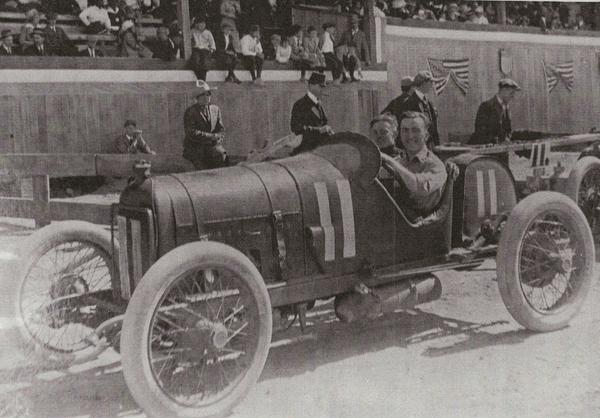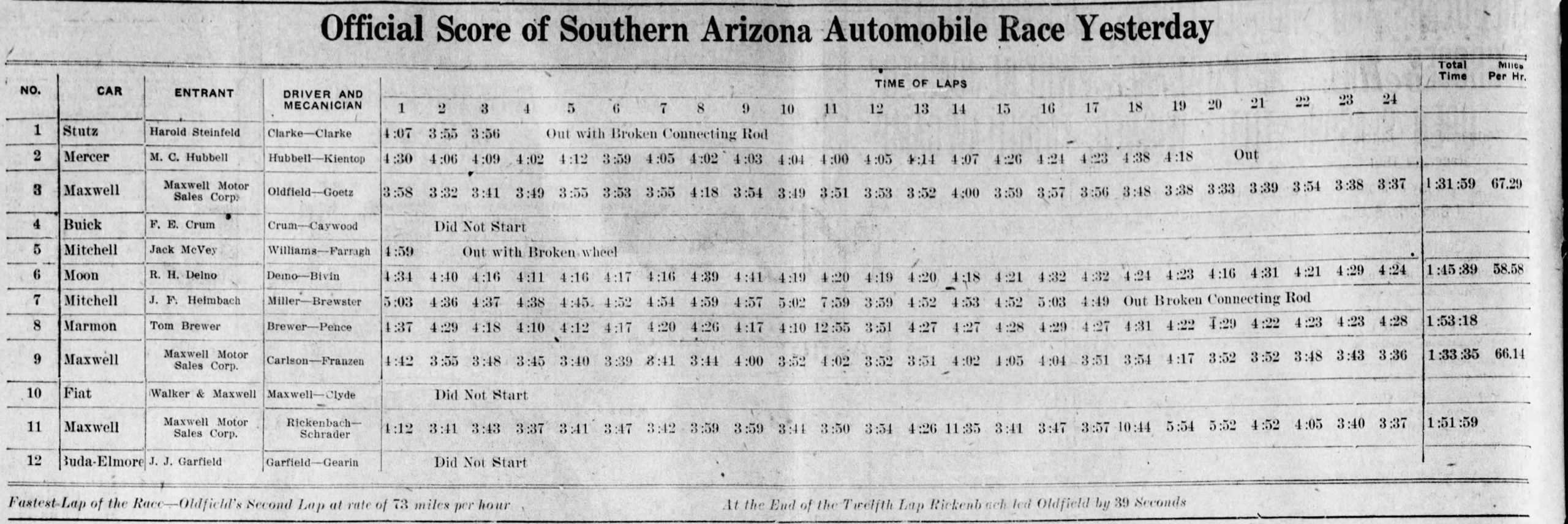
Not the usual subjects I look at, but was trying sort out the results of the Tucson Indy-car race on March 20, 1915.
One internet source I have shows the 11 runners. It has George Clark leading the first lap and Barney Oldfield (THE Barney Oldfield) leading the next 23 laps.
See: https://www.racing-reference.info/race-results/1915_Tucson_Race/UO/
But apparently in the real world, Eddie Rickenbacher was leading the race for a while (THE Eddie Rickenbacher, America’s top ace in the Great War).
So, an article on 21 March 1915 in The Arizona Daily Star, says in part:
Dick Clarke, who many of the fans had picked as Tucson’s best bet, got the jump on the start and beat the [Hubbell’s] Mercer into the first turn. Oldfield started like a shot out of a cannon and led the [McVoy’s] Mitchell…Rickenbacker, driving the last Maxwell, was hardly around the second curve when the crowd commenced shouting “car coming!”….Doubt gave way to pandemonium as Dick Clarke shot past the stand, not only holding his own in first place but gaining. Six seconds later came another and the crowd went wild: it was the popular favorite Barney Oldfield who had passed the Mercer and was trying to catch the flying Stutz.
This is the lap in which Oldfield averaged 72 miles an hour and caused his manager to flash a signal to him when he passed his pit to take it easy. According to his manager, nothing on four wheels was going to stand that pace for a hundred miles of the bumpy dirt track.
Clarke Eliminated
Two more laps for Clarke and then a painful wait which ended when were Clarke brothers were seen walking toward the grandstand. “Broken connecting rod,” said Dick….
Meanwhile Rickenbacker, who before the race had remarked he would “win or smash” was driving like a demon. In the eighth lap he was 29 seconds ahead of Barney who driving like mad to keep away from the other two Maxwells who were after him. But the jinx decided that it was not a Rickenbacker day and in the thirteenth lap the “win or smash” driver went to the pits. Loose radiator connection and flooded spark plugs. Seven valuable minutes were spent making repairs and away again like the wind.”
So, it does appear that Dick Clarke led for first 2 or 3 laps, and by lap 8 Rickenbacher was in the lead until lap 13. Oldfield took the lead for the rest of the race.
There is a stat chart for the race in the paper:

Rickenbacher does note in his book Rickenbacker: An Autobiography, on page 62 that:
“The Maxwell Automobile Company had entered the racing field with a 3-car team and one extra car. Two well-known drivers, Barney Oldfield and Bill Carson, had already signed on, and I was the third. My role was to burn up the track and wear down the opposition while Oldfield and Carlson, less aggressive drivers, would hopefully come on strong in the last laps and win the race. Though we knew that the Maxwells were not superior racing cars, we hoped to hold our own in them through determination and driving skill, and it did work out that way.”
Photo drawn from: https://www.firstsuperspeedway.com/photo-gallery/rickenbacker-maxwell-1915-lr4
P.S. Spelling contradictions:
- Dick Clarke is spelled Clark in other sources and also referred to as “George Clark.”
- The Swiss-American Rickenbacker actually spelled his name at this time as Rickenbacher. He changed the spelling in 1918 to be less German, or to “take the Hun out of his name.” But, the Tucson newspaper spelled it with a “ck” for this race.
- Adolph Rickenbacher, his distant cousin and a luthier, established in 1931 the company that made the Rickenbacker guitars. He also changed the spelling of his own name and guitar brand to match. These guitars were made famous by the Beatles, the Byrds and Tom Petty.
P.P.S.: Ads in Thursday’s, Friday;s and Saturday’s paper:



Federico José María Ronstadt was the grandfather of famous country and rock singer Linda Ronstadt.
P.P.P.S: An ad in the Sunday paper, day after the race:

